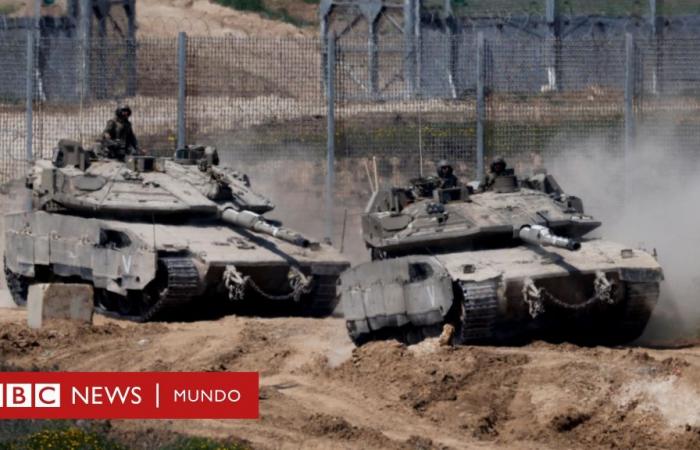Image source, Reuters
- Author, David Gritten
- Author’s title, BBC News
- Informs from Jerusalem
-
27 minutes
Israel’s security cabinet has approved a plan to expand its military offensive against Hamas that includes Gaza’s “capture” and permanence in its territory, according to an Israeli official.
It would also include the displacement of 2.1 million Palestinians from Gaza to the south, which could aggravate the humanitarian crisis.
Prime Minister Benjamin Netanyahu described him as “good plan” because he would achieve the objectives of defeating Hamas and return to the hostages that remain in his possession, said the official.
The cabinet also approved, in principle, a plan to deliver and distribute humanitarian aid through private companies, with which they ensure that a two -month block would end that, according to the UN, has caused a serious shortage of food.
The UN and other humanitarian aid agencies have affirmed that the proposal would mean a violation of the basic humanitarian principles and that they will not cooperate.
Hamas has assured that Israel’s proposal is equivalent to a “political blackmail.”
“Control the territories”
The security cabinet of Prime Minister Benjamin Netanyahu met Sunday night to discuss Gaza’s offensive, which resumed when Israel ended a high two -month fire on March 18.
An Israeli official who informed the media on Monday pointed out that the ministers unanimously approved a plan proposed by the Chief of the General Staff of the Israeli Armed Forces, Lieutenant General Eyal Zamir, to “defeat Hamas in Gaza and recover the hostages.”
“The plan will include, among other things, capture the strip and control the territories, displace the Gazatí population towards the south for their defense, to deny Hamas the ability to distribute humanitarian supplies and carry out blunt attacks against Hamas,” said the official.
The Israeli media reported that the plan would last months and that the first phase included the taking of additional areas of Gaza and the expansion of the “buffer zone” designated by Israel along the borders of the territory.
The objective would be to give Israel an additional advantage in the negotiations with Hamas over a new high fire and the release of hostages.
Zeev Elkin, a member of the Security Cabinet, told the public broadcaster Can that “there is still a window of opportunity” for a new release of hostages before President Trump’s trip to East from May 13 to 16 ends “if Hamas understands that we are serious.”
During a visit to a naval base on Sunday, Lieutenant General Zamir told the Special Forces that tens of thousands of reservists were being called rows “to reinforce and expand our operations in Gaza.”
“We are increasing the pressure with the aim of bringing our people home and defeating Hamas. We will operate in additional areas and destroy all the terrorist infrastructure, on and underground,” he said.
-However, critics claim that it is a failed strategy, since none of the remaining 59 hostages has been released since the offensive resumed six weeks ago.
The hostage and relatives forum, which represents the relatives of the hostages, said that the plan was the recognition by the government that it was “choosing territory before hostages” and that this was “against the will of more than 70% of the population” of Israel.
“Pressure Tactics”
Image source, EPA
The Israeli official said that the security cabinet also approved by a large majority “the possibility of a distribution of humanitarian aid – in case necessary – that prevented Hamas from taking control of supplies and destroyed their government abilities.”
On Sunday, the country’s humanitarian team (HCT), a forum in which UN agencies participate, said that the Israeli authorities intended to “close the current aid distribution system” and “make us accept the delivery of supplies through Israeli centers in the conditions established by the Israeli army, once the government agrees to reopen the border steps.”
The HCT warned that the plan would mean that wide areas of Gaza, including people with less mobility and the most vulnerable, would still not receive supplies.
“It contravenes the fundamental humanitarian principles and seems designed to reinforce control over vital items as pressure tactics, as part of a military strategy,” he said.
“It is dangerous, because it leads civilians to militarized areas to collect the portions, threatening their lives, including those of humanitarian workers, while further strengthening forced displacements.”
Israel cut all deliveries of humanitarian aid and other supplies to Gaza on March 2, two weeks before resuming his offensive.
According to the UN, the population faces a new risk of hunger and malnutrition because stores are empty, bakeries have closed and community kitchens are days after running out of supplies.
The blockade has also cut the supply of essential medicines, vaccines and medical equipment necessary for the overflowing Health system of Gaza.
The UN affirms that Israel is obliged by international law to guarantee supplies to the population of Gaza, almost all of it displaced. Israel states that international law is fulfilling and that there is no shortage of help.
The Israeli army launched a campaign to destroy Hamas in response to an unprecedented cross -border attack on October 7, 2023, in which some 1,200 people died and another 251 were taken as hostages.
At least 52,567 people have died in Gaza since then, 2,459 of them since the Israeli offensive resumed, according to the Gazati Ministry of Health.
Subscribe here To our new newsletter to receive every Friday a selection of our best content of the week.
And remember that you can receive notifications in our app. Download the latest version and act.






